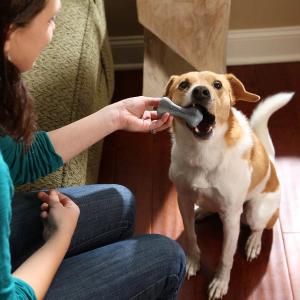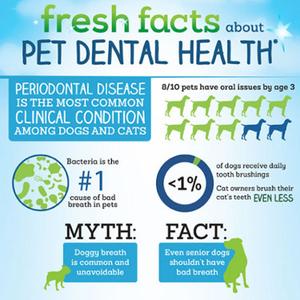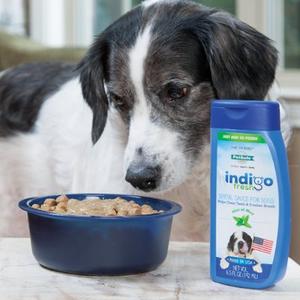By Dr. Patrick Mahaney, VMD
 A healthy smile starts with great pet dental health![/caption] Although February is Pet Dental Health Month, you shouldn’t wait until this wintery month rolls around to promote your pets’ dental health. Keep your pet’s mouth healthy all year long by taking good care of your pet’s teeth through a combination of professional and home dental care.
A healthy smile starts with great pet dental health![/caption] Although February is Pet Dental Health Month, you shouldn’t wait until this wintery month rolls around to promote your pets’ dental health. Keep your pet’s mouth healthy all year long by taking good care of your pet’s teeth through a combination of professional and home dental care.
Facts About Periodontal Disease
Periodontal disease is one of most common we veterinarians diagnose. Veterinary Pet Insurance (VPI) estimates that more than 80% of pets in the U.S. experience gum disease by age three. Like obesity, it is a preventable condition causing potentially irreversible and life-threatening health problems. It’s not just your pet’s teeth that affect oral health. Your pet’s teeth, gums and supportive structures including periodontal ligament and alveolar bone can all be affected by poor oral hygiene.
Periodontal disease starts with bacteria that form a thin layer called plaque on tooth surfaces above and below the gumline. Over time, plaque accumulates and forms tooth-staining tartar, which appears yellow to brown. Tartar then mineralizes into calculus, which is a thick, shell-like covering. This process isn't something that takes years to develop either. Carbohydrate residues create a prime medium on tooth and gum surfaces on which bacteria can thrive within the dark, warm, and moist environment of the mouth within hours of eating.
Negative Effects of Poor Oral Health
 Mild tartar gingivitis can build-up without proper dental health care. The old wives’ tale of dog and cat mouths being cleaner than human mouths is not true. Dog and cat mouths are quite unsanitary and house plenty of bacteria that could harm their internal organs or people who are bitten by a pet.
Mild tartar gingivitis can build-up without proper dental health care. The old wives’ tale of dog and cat mouths being cleaner than human mouths is not true. Dog and cat mouths are quite unsanitary and house plenty of bacteria that could harm their internal organs or people who are bitten by a pet.
The multiple facets of periodontal disease permits bacteria to move from the mouth into the blood and cause damage to the heart, kidneys, liver, pancreas and other body systems. Bacteria can also be inhaled into the respiratory tract and contribute to breathing problems including coughing, snoring, sneezing, wheezing, tracheal collapse and pneumonia.
Inflammation created by periodontal disease also negatively affects the immune system. White blood cells and inflammatory mediators that could otherwise be used to manage infection and inflammation in other body parts are targeted toward the mouth to keep bacteria from entering the blood.
Poor oral health also causes unnecessary immune system stimulation and can contribute to autoimmune diseases including IMHA and IMTP.
Periodontal Diagnosis & Treatment
The good news for pet owners is that there are many ways that periodontal disease can be treated in our canine and feline companions, including brushing, water additives, and dental cleanings either with or without anesthesia. In the veterinary world, there is some controversy about these procedures, as they vastly differ in their abilities to promote the best states of periodontal health.
The most thorough dental is performed under anesthesia. When a pet has been immobilized by an anesthetic, all tooth surfaces can be thoroughly evaluated both visually and via dental x-rays and then cleaned and polished. As a significant degree of periodontal disease occurs under the gumline, x-rays are vital to diagnosis and addressing problems that are otherwise unseen to the naked eye. Scaling under the gumline, extracting teeth, and thoroughly polishing tooth surfaces is nearly impossible with an awake or less than cooperative patient.An endotracheal tube also prevents aerosolized bacteria, chunks of tartar and calculus, and oral cavity fluids from entering the respiratory tract via the trachea.
An anesthesia-free dental can still help improve oral cavity health in the face of periodontal disease, but it will not be as thorough. American Veterinary Dental Society fellow Dr. Brett Beckman weighs in on non-anesthetic dentistry, stating that “most non-professional dental cleanings are done using some sort of hand curette. These tools cause scarring and micro-pitting of the enamel surface and this can actually accelerate plaque retention and tartar build-up!”
Essential in the dental care process is the step of polishing the tooth to smooth out enamel surfaces to reduce bacterial attachment, which is ineffectively performed without anesthesia. There are some cases where an anesthesia-free dental cleaning is a good option. Cooperative pets with mild dental disease who have health concerns that put them at risk for anesthetic complications (heart, lung, kidney, and liver diseases, etc.) are appropriate candidates for dental cleaning without anesthesia. In such cases, veterinary practitioners need to be flexible and offer the dental procedure that fits the patient’s needs even if it is not the best dental strategy available.
Preventing Periodontal Disease
 Give your dogs an indigo dental treat from PetSafe! The best practice is to prevent periodontal disease from happening instead of addressing it once bad breath or another associated health issues affect your pet. This takes dedication and consistency from you. When raising a child, parents brush their kid’s teeth until the child is able to do so on his own. Our dogs and cats never mature to the life stage where they are fully capable of addressing their dental health without at least some human assistance.
Give your dogs an indigo dental treat from PetSafe! The best practice is to prevent periodontal disease from happening instead of addressing it once bad breath or another associated health issues affect your pet. This takes dedication and consistency from you. When raising a child, parents brush their kid’s teeth until the child is able to do so on his own. Our dogs and cats never mature to the life stage where they are fully capable of addressing their dental health without at least some human assistance.
Promoting pet periodontal health is a lifelong concern. Although most pet owners like to think that their pet’s dry food and chewing habits sufficiently promote optimal dental health, this is far from the truth. Dry food (kibble) shatters when the pet’s tooth penetrates the surface and provides no cleansing effect unless a veterinary prescription dental diet is fed. Instead of being thoroughly chewed, kibble is often gulped down whole and provides no teeth-cleaning effect, leading to excessive calorie consumption and inefficient digestion of food.
Pets who like to chew toys, bones or dental treats can help to improve their own periodontal health. This is a great step but an incomplete one. Overzealous chewing of hard materials can lead to dental fractures and gingival bleeding, so watch your pet’s chewing habits. Not all tooth surfaces or mouth parts are cleaned by the chewing process. You’ll still need to clean your pet’s teeth on a daily basis with a moistened toothbrush or dental wipe and a pet-friendly toothpaste. Start daily cleaning early in your pet’s life so your pet can get used to the process. Your pet will thank you for your dental health promoting efforts.





